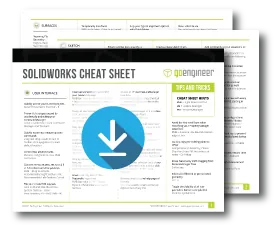SOLIDWORKS Materials in Multibody Parts
In SOLIDWORKS, materials in multibody parts work similarly to materials in single body parts, except you can assign materials to individual bodies to override the main part material. When you apply a material to the whole part (at the top of the FeatureManager Design Tree, as you would with a single body part), each body automatically inherits the material. This is exactly how single body parts work. You can then specify different materials for specific bodies if desired. This allows you to create your model as simple or as detailed as you want.

Assigning a Primary Material
To assign a material to the whole part, right-click the material row in the FeatureManager Design Tree and select Edit Material. This opens the material dialog box. Whatever you select here becomes the default material for all bodies in the part file.

Assigning Additional Materials
To specify a different material for a specific body, right-click on the body in either the Solid Bodies folder or Cut List folder in the FeatureManager Design Tree. Select Material and then Edit Material. This opens the same material dialog as before.

When Materials Are Retained and When They Aren’t
The material specified for a specific body overrides the material specified in the FeatureManager Design Tree for the whole part file. When you create a new body from an existing body, it retains the material applied to the original body. This applies to mirrored parts and parts that are copied and inserted. If you insert a body into a new part file, it retains the material, but the new part file retains whatever primary material selection has already been made.
When inserting a multibody part into an assembly, the materials appear exactly as they did in the original part file.
Saving Out Bodies as Separate Parts
When saving out the bodies of a multibody part as individual part files, each new part file inherits the material applied to the original body. Each new part file also retains an external reference to the original multibody part. To change the material in the new part file, either change the material in the original multibody part (the master model), change the material within the Solid Bodies folder for the specific body, or break the external reference to the original file. To do this, right-click the top of the FeatureManager Design Tree and select External References.

Configurations and As Welded vs As Machined
Bodies can have their own materials that are unique to each configuration. A useful application of this is to specify materials for the As Welded and As Machined configurations for weldment parts. A part or solid body may have a custom material applied to it that carries specific customizations (such as appearances), so you can visually see the difference between welded and machined, for example.

Using Body Materials in a BOM or Cut List
Materials specified for bodies will display the same in the Bill of Materials or Cut List as they do in the original part file. All material specifications are linked to the original part file and will be inherited by the drawing.

Understanding how to effectively assign and manage materials within multibody parts in SOLIDWORKS is essential for achieving accurate and detailed representations of your designs. By utilizing the features that allow for both primary and individual body materials, users can create models that reflect the complexity of real-world applications.
I hope you found this article explaining SOLIDWORKS materials in multibody parts helpful. Check out more tutorials below. Additionally, join the GoEngineer Community to create forum posts, enter design contests, and answer questions from other SOLIDWORKS users.

SOLIDWORKS CAD Cheat Sheet
SHORTCUTS ⋅ MOUSE GESTURES ⋅ HOT KEYS
Our SOLIDWORKS CAD Cheat Sheet, featuring over 90 tips and tricks, will help speed up your process.
Related Articles
How to Reorder SOLIDWORKS Sheet Metal Bends
SOLIDWORKS STEP Export: AP203 vs AP214
Automatic Unit Conversion in SOLIDWORKS File Properties
Exploded Views for SOLIDWORKS Multibody Parts
Faster DWG Conversions Using the SOLIDWORKS 2D to 3D Toolbar

About Gary Ballentine
Gary Ballentine is a Mechanical Engineer based out of our Headquarters in Salt Lake City, Utah. He earned a Bachelor’s degree from the University of California, Davis, a certification in Technical Writing from San Francisco State University, and a Bachelor’s degree in Mechanical Engineering from the University of Utah. Gary has been part of the GoEngineer family since April 2019 as a Support Engineer and Certified SOLIDWORKS Instructor.
Get our wide array of technical resources delivered right to your inbox.
Unsubscribe at any time.